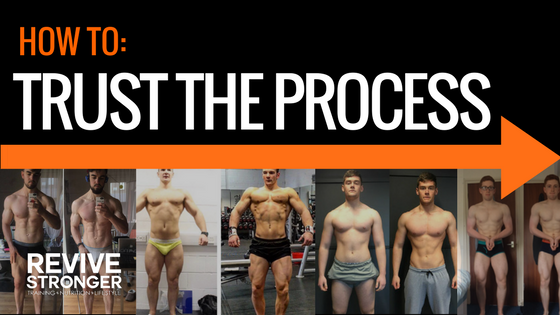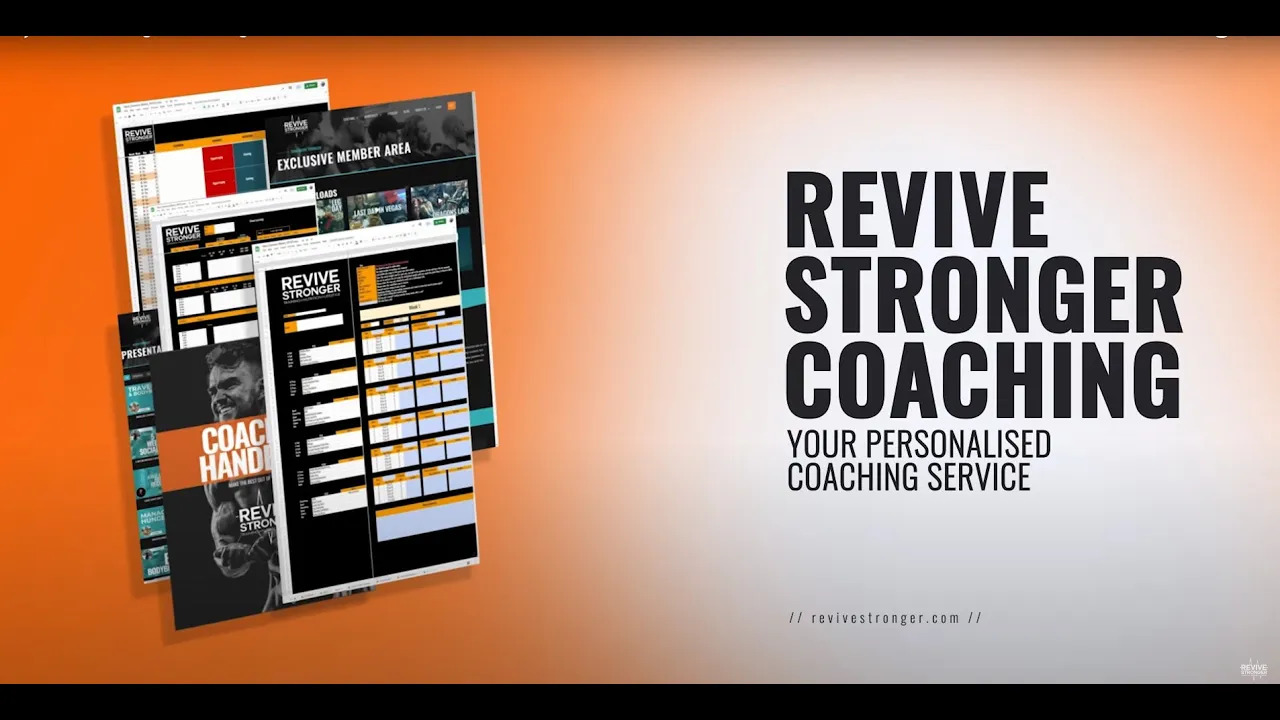
Revive Stronger
How to Trust the Process

The phrase “trust the process” is often thrown around in our realm.
What does it really mean to trust the process?
What does it actually look like?
Ryan Solomon one of the interns at Revive Stronger is going to take you through how you can trust the process & why it’s important. He will also go over some personal experiences of his own, where he has let himself down and also how he has succeeded.
This article is going to cover a few different points:
- Trusting your body/science
- Trusting your coach/self
- Real-world examples of my experience trusting the process, and what you can learn from my (stupid) mistakes.
Table of Contents
Trusting Your Body
News flash, you’re probably not a special snowflake.
Basic scientific principles apply to us all, you me & your brother.
Examples of these principles include:
- Energy balance
- Specificity
- Progressive overload
- Diminishing returns
Etc. etc.
What about those who are “hardgainers” or who can only gain fat, or those who can’t seem to drop any fat, or even just can’t get any stronger?
My intuitive thought is to basically just call bullshit, and ask them if they are NAILING all of the basic principles like having a progressively overloading training regime, and being in a caloric deficit or surplus.
Okay, there are people who have to eat more than others to get bigger, and there are some who gain more fat while bulking than others, and maybe you may struggle to lose fat more than others. However, if you nail the basic principles, you will get to where you want to be eventually.
You just need to TRUST THE PROCESS.
The worst thing you could do is give up after not seeing progress. Re-evaluate your program and analyze if you’re nailing the basic principles. If you are, than great, it’s probably just going to take a bit of consistent effort. Possibly you’ll need some tweaking of certain variables, to get where you want to be, a place where you’ll never end up if you don’t trust the process.
Now that you know you’re probably not some special case where basic principles don’t apply to you, let’s move onto trusting your coach, whether that’s yourself or someone you hired.
Trusting Your Coach/Self
If you’re paying your hard-earned money for a coach, I’m sure you’ve researched their methods, and you know they are an educated professional.
So you should know that they’re going to make the best decisions for you. One of the best reasons for having a coach is to have an objective eye looking over your progress, and to take the stress off of you worrying about your program.
^ Do this, and allow them to do their job.
Trusting your coach, and trusting the decisions they make for you, is why you’re paying them. If you don’t trust them, and you don’t trust the process, then they can’t effectively coach you. This will lead to a lack of progress, with no-one to blame but yourself.
Trusting your coach includes:
- You execute their plan with 100% effort
- You ask good questions that help you understand their programming
- You pass anything you want to change or modify past your coach before just doing it
Now, let’s say you’re self-coached.
You’ve taken steps to educate yourself, and you know enough to create a sound program.
Next step comes with trusting yourself.
Trust that you put a sound program together, and don’t make changes every single week if nothing is happening. Building muscle, and losing fat takes time. If your fat loss stalls for a week, give it another week before creating a larger deficit. If your arm measurements/lifts in the gym haven’t gone up this month, give it another month and see where you’re at.
Once it does come time to make a change, only changing one or two variables is a great idea. This allows you to see if those variables were the reasons you weren’t making any progress. This way you become your own case study, and can see how you personally respond to different variables.
As you can see, this is just one big process of finding what works best for you. You can never find this out if you don’t give anything the amount of time it needs to actually see if it works.
I’ve made the mistake in the past of making a new program for myself every 2 weeks. I would be in the middle of a training program and I’d find myself writing a completely new program for myself from scratch.
This resulted in me losing focus on my current program, and becoming less motivated to execute it. Leading to shitty progress.
Believe it or not, this isn’t the only time I’ve struggled trusting the process, let me give you another example below.
When I Wasn’t Successful Trusting The Process
When dieting down, I’ve totally screwed up trusting the process.
I was dropping weight consistently, but then one week, it stalled. I thought I messed up, and made the mistake of cutting my calories by far too much, and adding in excessive cardio.
Know what happened? I weighed in the following week roughly 5 pounds lighter. I thought hey, this is pretty GREAT, right?
WRONG.
I was losing far too fast (especially considering I was about 165 pounds, and didn’t have very high body fat levels).
Know what happened when I did this?
- Strength plummeted.
- Ended up maintaining weight on about 1600-1700 calories.
- Lost muscle.
I ended up looking a bit skinny fat, and regressed in my training. This was a very depressing time for me, as I thought all of my work over the last few years was wasted. So yeah, DON’T DO THAT.
Instead, if you’ve been consistently losing weight, and then one week nothing happens. Give it another week. Then, if still nothing has moved, slightly increase your caloric deficit.
If you want to learn more about finding the “sweet spot” of not losing too fast, and not too slow, check out Steve’s great article here.
This takes a bit of patience in practice, but just think to yourself, what’s worse? Losing hard-earned muscle by not trusting the process, or by being a bit more patient and making sure that the caloric deficit needs to be increased.
Obviously, I wasn’t successful trusting the process here, but let’s take a look at a time when I actually was successful.
When I Was Successful Trusting The Process
When I start a massing/bulking phase, and start to eat quite a lot of carbs, I simply look a bit more fluffy and my “stubborn fat” areas tend to fill out right away.
This initial difference in how I look is sometimes difficult to deal with, and I’m tempted to go right back to cutting.
Not wanting to be stuck in the continuous cutting cycle, I stuck to my gaining phase, and really saw some great progress. My lifts all went up, my measurements went up in the right places..
So what can you take away from this practically?
At the start of a bulk, you may look quite a bit different right away because of all the extra food/carbs, especially if you were overweight previously. If you were overweight, I’m of the opinion that those fat cells previously generated will indeed fill out a bit (because you can’t actually eliminate the number of fat cells you have). Not to say you’ll just get fat, but you’ll probably look a bit more fluffy.
What to do about this?
Accept that you’re not an individual that is just going to look super lean year-round. Trust that you need to invest in gaining some weight gain, and look a bit “worse” now, to be able to look that much better in the future.
Hopefully that helps you become more accepting of that initial visual difference on a bulk, and that you’ll be able to stick to the process better because of it.
Now, let’s move to when I trusted the process a bit too much.
When I Trusted The Process Too Much
As with anything, too much of it, probably isn’t a good thing… well, except for muscle, I’ll take “too much” of that please.
If you blindly put your head down and stick to a program, and don’t monitor your results or how you’re progressing, then you’re trusting the process too much.
This isn’t to say that you shouldn’t give each program a fair go, but it is to say that if you haven’t gotten closer to your goals the past 3-4 months, something needs to be changed.
I’ve made this mistake in the past.
I stuck to a 4 day/week, very low volume program, while I was recovering from an appendectomy and couldn’t train with a barbell. So basically, I did a few sets with dumbbells and cables in the lower rep range, thinking that I wouldn’t have any trouble adding muscle.
I had the perception that the caloric surplus would build me muscle. This is an erroneous view-point. The main stimulus for muscle growth is your TRAINING program, the diet just PERMITS this adaptation to take place.
- No training stimulus = No meaningful muscular adaptations
- No Calorie Surplus = No new muscle tissue (well, most of the time)
To no one’s surprise, this was far too little volume to stimulate growth, especially since I had already been training for a couple of years. This resulted in me putting on far too much fat during my gaining phase, and I ignored the signs that something may need to be changed.
These signs included:
- My waist measurement was going up, but my arm/chest/leg measurements were all staying the same.
- All I saw in the mirror was more and more fat, no new gains were noticed. <<< This one can be tricky, because we will ALWAYS notice the fat gain more so than the muscle gain.
- When I cut back down to my starting bodyweight, I looked the same. If not worse. << The best indicator
The better choice would have been to maintain until I was recovered. Adding a surplus once I could provide more of a stimulus for growth through higher volume, progressive, compound-lift training.
As you can see, I’ve done some stupid shit throughout my training history. This is just another great reason why a coach can be so helpful. If a client were in the same situations I was in, I wouldn’t have ever recommended the decisions I made, because it’s hard to be objective with yourself.
I’m constantly working on this.
In my opinion, as long as I keep learning from my mistakes, monitoring my progress, and relentlessly working towards my goals without ever quitting, I’ll eventually get there.
Hopefully, from my experience, you can learn that there’s a balance to be made between trusting the basic principles and blindly following a program no matter the results.
Take-home Points From This Article
- Know the basic scientific principles apply to you.
- Trust your coach.
- Don’t make drastic changes to your program based on short-term evidence.
- Give a program sufficient time to see if it’s getting you closer towards your goals, but if after 3-4 months you haven’t moved anywhere, then I’d head back to the drawing board.
- If you look a bit fluffy at the start of a bulk, that’s indeed OKAY. It’s an investment to look better in the future – read this for help
- You have your entire life to make progress and lift weights, there’s no need to get in a big hurry.
- Have fun, and enjoy the process.
What Next?
Join our free facebook group or add us on Instagram (revivestronger) and ask your question there, I will respond asap. Or if you’re after a fresh training programme we have a free 4 week plan using DUP that you can download for free here.
One more thing…
Do you have a friend who would love the above?
Share this article with them and let me know what they think.
[bctt tweet=”How to Trust the Process” username=”revivestronger”]
We are a personal coaching service that helps you achieve your goals. We want you to become the best version of yourself.









1 thought on “How to Trust the Process”
Pingback: Google
Comments are closed.